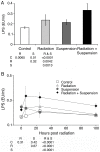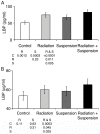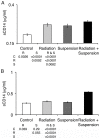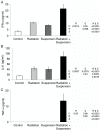Effect of solar particle event radiation and hindlimb suspension on gastrointestinal tract bacterial translocation and immune activation
- PMID: 23028522
- PMCID: PMC3446907
- DOI: 10.1371/journal.pone.0044329
Effect of solar particle event radiation and hindlimb suspension on gastrointestinal tract bacterial translocation and immune activation
Abstract
The environmental conditions that could lead to an increased risk for the development of an infection during prolonged space flight include: microgravity, stress, radiation, disturbance of circadian rhythms, and altered nutritional intake. A large body of literature exists on the impairment of the immune system by space flight. With the advent of missions outside the Earth's magnetic field, the increased risk of adverse effects due to exposure to radiation from a solar particle event (SPE) needs to be considered. Using models of reduced gravity and SPE radiation, we identify that either 2 Gy of radiation or hindlimb suspension alone leads to activation of the innate immune system and the two together are synergistic. The mechanism for the transient systemic immune activation is a reduced ability of the GI tract to contain bacterial products. The identification of mechanisms responsible for immune dysfunction during extended space missions will allow the development of specific countermeasures.
Conflict of interest statement
Figures






Similar articles
-
Effect of solar particle event radiation on gastrointestinal tract bacterial translocation and immune activation.Radiat Res. 2011 Apr;175(4):485-92. doi: 10.1667/RR2373.1. Epub 2011 Feb 4. Radiat Res. 2011. PMID: 21294608 Free PMC article.
-
Hindlimb suspension and SPE-like radiation impairs clearance of bacterial infections.PLoS One. 2014 Jan 15;9(1):e85665. doi: 10.1371/journal.pone.0085665. eCollection 2014. PLoS One. 2014. PMID: 24454913 Free PMC article.
-
Broad-spectrum antibiotic or G-CSF as potential countermeasures for impaired control of bacterial infection associated with an SPE exposure during spaceflight.PLoS One. 2015 Mar 20;10(3):e0120126. doi: 10.1371/journal.pone.0120126. eCollection 2015. PLoS One. 2015. PMID: 25793272 Free PMC article.
-
Anorexia in space and possible etiologies: an overview.Nutrition. 2002 Oct;18(10):805-13. doi: 10.1016/s0899-9007(02)00915-2. Nutrition. 2002. PMID: 12361771 Review.
-
Use of animal models for space flight physiology studies, with special focus on the immune system.Gravit Space Biol Bull. 2005 Jun;18(2):31-5. Gravit Space Biol Bull. 2005. PMID: 16038091 Review.
Cited by
-
Apoptosis, Mitochondrial Autophagy, Fission, and Fusion Maintain Mitochondrial Homeostasis in Mouse Liver Under Tail Suspension Conditions.Int J Mol Sci. 2024 Oct 18;25(20):11196. doi: 10.3390/ijms252011196. Int J Mol Sci. 2024. PMID: 39456978 Free PMC article.
-
Spaceflight impairs antigen-specific tolerance induction in vivo and increases inflammatory cytokines.FASEB J. 2015 Oct;29(10):4122-32. doi: 10.1096/fj.15-275073. Epub 2015 Jun 17. FASEB J. 2015. PMID: 26085131 Free PMC article.
-
Simulated Microgravity Alters Gene Regulation Linked to Immunity and Cardiovascular Disease.Genes (Basel). 2024 Jul 24;15(8):975. doi: 10.3390/genes15080975. Genes (Basel). 2024. PMID: 39202335 Free PMC article.
-
Synergistic interplay between radiation and microgravity in spaceflight-related immunological health risks.Immun Ageing. 2024 Jul 20;21(1):50. doi: 10.1186/s12979-024-00449-w. Immun Ageing. 2024. PMID: 39033285 Free PMC article. Review.
-
Monte Carlo modeling in CT-based geometries: dosimetry for biological modeling experiments with particle beam radiation.J Radiat Res. 2014 Mar 1;55(2):364-72. doi: 10.1093/jrr/rrt118. Epub 2013 Dec 5. J Radiat Res. 2014. PMID: 24309720 Free PMC article.
References
-
- Aponte VM, Finch DS, Klaus DM (2006) Considerations for non-invasive in-flight monitoring of astronaut immune status with potential use of MEMS and NEMS devices. Life Sci 79: 1317–1333. - PubMed
-
- Mallis MM, DeRoshia CW (2005) Circadian rhythms, sleep, and performance in space. Aviat Space Environ Med 76: B94–107. - PubMed
-
- Cena H, Sculati M, Roggi C (2003) Nutritional concerns and possible countermeasures to nutritional issues related to space flight. Eur J Nutr 42: 99–110. - PubMed
-
- Shearer WT, Zhang S, Reuben JM, Lee BN, Butel JS (2005) Effects of radiation and latent virus on immune responses in a space flight model. J Allergy Clin Immunol 115: 1297–1303. - PubMed
Publication types
MeSH terms
LinkOut - more resources
Full Text Sources

